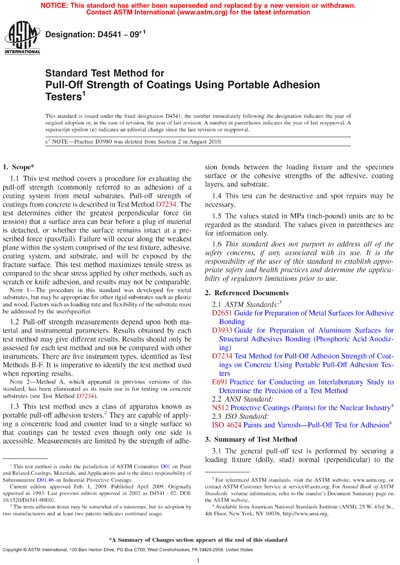Historical
ASTM D4541-09e1
Standard Test Method for Pull-Off Strength of Coatings Using Portable Adhesion Testers
1.1 This test method covers a procedure for evaluating the pull-off strength (commonly referred to as adhesion) of a coating system from metal substrates. Pull-off strength of coatings from concrete is described in Test Method D7234. The test determines either the greatest perpendicular force (in tension) that a surface area can bear before a plug of material is detached, or whether the surface remains intact at a prescribed force (pass/fail). Failure will occur along the weakest plane within the system comprised of the test fixture, adhesive, coating system, and substrate, and will be exposed by the fracture surface. This test method maximizes tensile stress as compared to the shear stress applied by other methods, such as scratch or knife adhesion, and results may not be comparable.
Note 1—The procedure in this standard was developed for metal substrates, but may be appropriate for other rigid substrates such as plastic and wood. Factors such as loading rate and flexibility of the substrate must be addressed by the user/specifier.
1.2 Pull-off strength measurements depend upon both material and instrumental parameters. Results obtained by each test method may give different results. Results should only be assessed for each test method and not be compared with other instruments. There are five instrument types, identified as Test Methods B-F. It is imperative to identify the test method used when reporting results.
Note 2—Method A, which appeared in previous versions of this standard, has been eliminated as its main use is for testing on concrete substrates (see Test Method D7234).
1.3 This test method uses a class of apparatus known as portable pull-off adhesion testers. They are capable of applying a concentric load and counter load to a single surface so that coatings can be tested even though only one side is accessible. Measurements are limited by the strength of adhesion bonds between the loading fixture and the specimen surface or the cohesive strengths of the adhesive, coating layers, and substrate.
1.4 This test can be destructive and spot repairs may be necessary.
1.5 The values stated in MPa (inch-pound) units are to be regarded as the standard. The values given in parentheses are for information only.
1.6 This standard does not purport to address all of the safety concerns, if any, associated with its use. It is the responsibility of the user of this standard to establish appropriate safety and health practices and determine the applicability of regulatory limitations prior to use.
Content Provider
ASTM International [astm]






